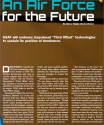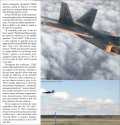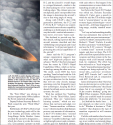Brumby
Major
USAF backs off sixth-gen 'fighter' in quest for air supremacy
The US Air Force will begin an extensive campaign of prototyping and experimentation relating to new air superiority technologies, including new aircraft types, after completing a wide-ranging examination of future air battle concepts and weaponry.
According to service officials, there’s no “silver bullet” or “exquisite” next-generation fighter jet that will single-handedly evade and counter the types of surface-to-air, air-to-air, anti-satellite, electronic attack and cyber threats that are springing up around the world, particularly if going up against a nuclear-armed state like Russia or China.
Instead, the air force will proceed with many parallel technology development efforts, like new propulsion systems, airframes, directed energy weapons and hypersonic missiles, to develop a “family of systems” – including longer-range, higher-payload platforms to launch volleys of weapons at targets from “standoff” distances and others that will swoop in for direct attacks.
Lt Gen James “Mike” Holmes, USAF deputy chief of staff for strategic plans and requirements, says his team is moving away from terms like “fighter” and “next-generation” and will instead look at completely different ways of doing air warfare in the future.
His personal ambition would be to have an “operationally representative configuration” of this future air superiority network in place by 2025. The service has even delayed by one year its F-X or Next-Generation Air Dominance (NGAD) analysis of alternatives to avoid ending up with requirements for another generation of fighter.
“F-X would have been most likely like a sixth-generation fighter and would have had a 20 or 30-year development programme,” Holmes said at an Air Force Association forum in Washington DC on 7 April. “What we want to try to do is solve the problem faster than that by looking out across the range of options and building what we’re capable of building instead of waiting for the next generation.”

Northrop Grumman's future fighter concept
Northrop Grumman
For the past year, an air force “enterprise capability collaboration team” has been processing over 1,500 submissions from 14 organisations on 220 different initiatives related to achieving air superiority in 2030.
Of those submissions, almost half proposed new equipment, while others pushed modernisation of existing hardware, new battle concepts or tactics, techniques and procedures.
Based on that information, the air force has concluded that only a highly networked collection of weapon systems will be capable of tackling future threats, not just one or two new platforms with long development cycles. By contrast, it has taken more than 16 years for the service to produce its first war-ready combat squadron of Lockheed Martin F-35As, and the F-22 also took longer than planned.
The F-35 isn't outdated, says Holmes, but the technology demanded was so complex that "it took longer than we hoped to achieve".
“Exquisite capabilities ended up being late-to-need,” says USAF chief of strategic planning and integration Col Alex Grynkewich, who led the Air Superiority 2030 effort. “This generational paradigm is outdated. We needed that integrated network of capabilities; there is no silver bullet.”
Grynkewich says range and payload are critical, but some studies show that speed, manoeuvrability and some level of low-observable shaping or stealth still have their place.
There’s also a place for automation and human-machine teaming, through concepts like “loyal wingman” that pair manned and unmanned combat jets.

USAF officials won't rule out derivatives of the Northrop B-21
US Air Force
Grynkewich also wants to operationalise combat-focused space and cyber forces, since cyber warfare is now a weapon of war and because so many weapon systems rely on vulnerable space assets.
Money has been included in the air force's fiscal year 2017 budget to begin advance prototype efforts, but some members of the family of systems are already under development or being matured.
Holmes says a meeting will be convened with US Air Force Materiel Command leadership in May to examine ways of moving faster through the acquisition process. USAF will also involve rapid acquisition organisations within US Special Operations Command as well as its secretive Big Safari office.
The planning chiefs did not rule out building derivatives of existing aircraft or even the Northrop Grumman B-21 bomber. Modest investments will also be made to upgrade and life-extending fourth-generation aircraft and modernise the F-22 Raptor.




